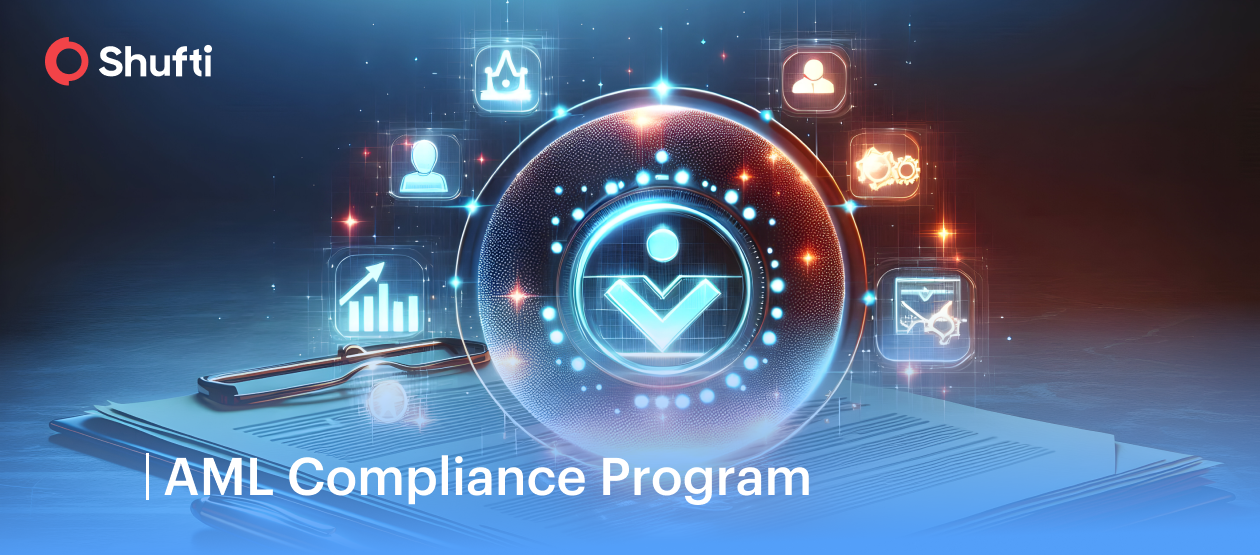AML Compliance Program

An Anti Money Laundering (AML) compliance program is a set of internal policies and procedures adopted by financial institutions and other regulated businesses to detect, prevent, and report money laundering and terrorist financing. These programs are critical to fight against financial crimes and maintain the integrity of the global financial system. Global laws and regulations such as the Bank Secrecy Act (BSA), the USA PATRIOT Act and the European Union’s 5th and 6th Anti-Money Laundering Directives drive institutions to invest in stronger compliance frameworks. In addition to new regulations, new technologies are also transforming the way AML compliance is approached in the present as well as the future.
Purpose of AML Compliance Program
An AML compliance program works as a proactive defense against financial crime. It arms organizations with the tools they need to identify suspicious activity, report it to the proper regional authorities (e.g., FinCEN in the U.S.), and ensure that illicit funds don’t take shelter in legitimate systems.
However, the program is not just about checking regulatory boxes, it’s about building strong internal controls and a culture of compliance that can detect, deter, and disrupt criminal behavior. A robust AML program will work harmoniously with cutting edge AML and Counter-Terrorist Financing (CTF) standards.
Having a program grounded in regulatory knowledge and reviewed by compliance experts helps build confidence across all levels of the organization and assures regulators that the business is serious about its obligations.
Pillars of the Compliance Program
An organization’s senior management positions play a significant role in the development and shaping of AML compliance programs. The size and structure of the program varies depending on the nature of their business, but every program typically follows a set of key principals, often referred to as the “pillars” of AML compliance:
- Internal controls
- Designation of a compliance officer
- Ongoing training
- Independent testing or auditing
- Risk-based customer due diligence
AML Controls
Study AML programs prioritize the development of better tools to detect and report financial crimes as they happen. These tools need to be reassessed regularly to ensure that they are effective and in line with best security practices.
Some of the most critical internal controls focus on Customer Due Diligence (CDD), transaction monitoring, and employee awareness. The controls help staff understand how to better utilize AML policies in practical situations and ensure compliance becomes natural throughout all departments.
Some of the most important AML controls include:
- Screening customers during onboarding
- Verifying customer identity before authorizing transactions
- Ongoing risk monitoring through dynamic screening
- Reporting transactions that exceed legally defined thresholds
AML Screening of Individuals and Corporates
AML screening forms the first line of defense against money laundering. Screening procedures involve checking if individuals and businesses appear on global watchlists, sanctions databases, politically exposed persons (PEPs), and adverse media reports.
Modern AML screening solutions are able to integrate thousands of data sources and use automated systems to run comprehensive checks instantly. The tools help to reduce manual errors and allow businesses to onboard customers faster without compromising compliance.
Internal and External Audits
Audits, both internal and external, are a core part of any AML compliance program. External audits, which tend to occur every 12 to 18 months, help ensure the organization meets regulatory requirements. It is common for businesses operating in high-risk sectors like crypto, gaming, or cross-border finance to have more frequent checks.
Internal audits help prepare companies for larger inspections. They involve evaluating employee adherence to AML policies, assessing the effectiveness of reporting systems, and identifying system weaknesses before regulators do.
AML Compliance Expert
A dedicated AML Compliance Officer ensures the company’s AML obligations are consistently met. This individual oversees the company’s entire AML framework and acts as the liaison between the business and regulatory bodies.
Some key responsibilities of the AML officer include:
- Detecting and reporting suspicious activities
- Conducting employee training on AML procedures
- Ensuring company-wide adherence to AML standards
- Updating policies in line with changing regulations
- Mapping out long-term AML compliance strategies
Recent AML Compliance Updates
As of this year, several important developments are shaping how AML compliance is implemented, both now and in the future:
- Corporate Transparency Act (CTA): In the U.S., the CTA now requires many companies to report beneficial ownership information to FinCEN, making it more difficult for shell companies to be used as cover for financial crime.
- Risk-Based Program Modernization: FinCEN is pushing for AML programs to be more tailored to the risk of each institution, instead of a generic one-size-fits-all approach.
- AI and Machine Learning: AML systems are now increasingly harnessing the power of AI and ML to enhance transaction monitoring, reduce false-positives, and catch complex money laundering patterns that humans might miss.
- Establishment of AMLA: The EU has recently launched the Anti-Money Laundering Authority (AMLA), a centralized body based in Frankfurt that oversees AML supervision and ensures consistent enforcement across all member states.
- Wider Scope of Regulations: AML obligations now cover a broader set of industries, including crypto exchanges (see MiCA in the EU), real estate professionals, luxury goods dealers, and even art markets as criminals look for new avenues to exploit the financial system.
Final Thoughts
In today’s fast-paced regulatory landscape, an effective AML compliance does more than just satisfy regulatory demand, it protects a company’s reputation, builds consumer trust, and works as a shield against sophisticated criminal networks. As money laundering efforts grow more advanced, businesses must evolve just as quickly, embracing smarter tools and more agile strategies to stay ahead.
The future of AML lies in programs that are not just thorough, but also intelligent by blending expert oversight with AI-driven analytics, and pairing traditional controls with dynamic, risk-based approaches. With regulators tightening standards and the financial ecosystem expanding into new industries, compliance is about more than just meeting expectations, it’s about setting a higher standard for integrity.



